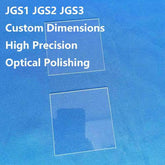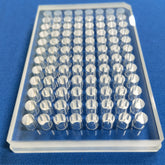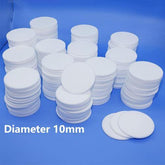Applications of Sapphire Lenses in Different Optical Products
Sapphire lenses, renowned for their exceptional hardness, superior optical performance, thermal stability, corrosion resistance, and chemical inertness, are widely used across diverse optical applications. The following outlines key application scenarios of sapphire lenses in various optical products.
1. Consumer electronics
(1) Mobile phone camera lenses
Owing to their high scratch resistance and excellent light transmittance, sapphire lenses are utilized as protective lenses for mobile phone cameras, effectively preventing surface damage and enhancing overall image quality.
(2) Smartwatch crystal
Sapphire glass, due to its high hardness and scratch resistance, is often used in the crystal of smartwatches to protect the screen from daily wear and tear.
2. Optical instruments and equipment
(1) Endoscopes lenses
Sapphire lenses are used as protective windows or objective lens components in endoscopes. Their extremely high hardness and wear resistance can reduce the risk of scratches during surgery and extend the service life of the equipment.

(2) Microscopes and telescopes
Sapphire lenses are used in the manufacture of optical components such as microscope and telescope lenses. These lenses are renowned for providing clear imaging effects and for being resistant to the damaging effects of inclement environments.
(3) Optical experimental instruments
Sapphire lenses are used to manufacture high-strength optical components, such as lenses, prisms and mirrors, for optical experimental instruments, due to their excellent physical and chemical properties.
3. Sensors and detectors
(1) High temperature sensors
Sapphire optical fibers feature high melting points, low transmission losses and high strength, making them suitable for temperature measurement over a wide range from room temperature to 1800℃, such as in special environments like high-frequency resistance heating and plasma-assisted vapor deposition.
(2) Pressure sensors and thermoluminescence detectors
Sapphire lenses are used to make high-temperature resistant and corrosion-resistant pressure sensors and thermoluminescence detectors, enhancing the stability and reliability of equipment.

4. Lighting and display field
(1) LED lighting
Sapphire is a highly versatile substrate material for LEDs due to its moderate dielectric constant, low dielectric loss, high hardness, wear resistance and good chemical stability. It is a popular choice in a range of applications, including landscape, decoration and lighting.
(2) High-pressure sodium lamp housing
Sapphire shells exhibits higher transmittance, lower energy consumption and a longer service life, giving them a competitive advantage over polycrystalline shells.
5. Other special applications
(1) X-ray monochromators
Sapphire is characterized by its exceptional stability over a broad spectrum of temperatures and pressures, making it a preferred material for the fabrication of gratings for X-ray monochromators.

(2) Infrared night vision devices and thermal imagers
Sapphire lenses are used in the windows of infrared night vision devices and thermal imagers to receive and emit infrared light while protecting the internal optical components.
Sapphire lenses continue to extend the performance limits of optical materials. The expansion of their application domains is driven by three core value propositions: maintaining optical stability under harsh environmental conditions, enabling equipment miniaturization through material innovation, and reducing total life cycle costs via exceptional durability. With ongoing advancements in fabrication processes, this “transparent corundum” is poised to play an important role across an expanding range of technological fields.






